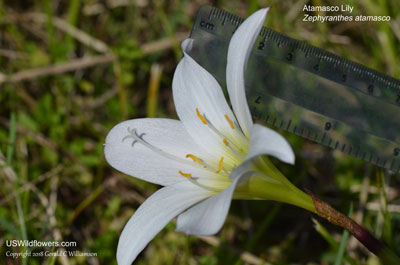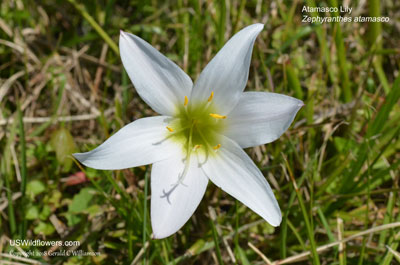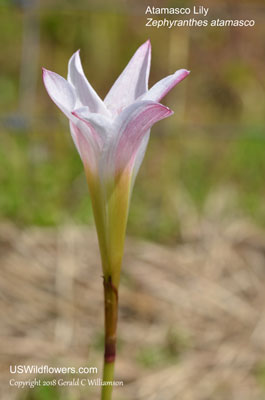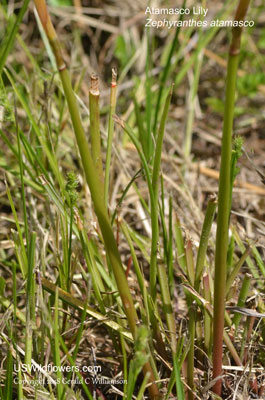Wildflowers of the United States | |||||||||||||
| |||||||||||||
Zephyranthes atamasco - Atamasco Lily, Rain Lily, Easter-lily, Naked Lady. | Zephyranthes is a moderately-sized genus of small lilies with about 70 species worldwide, of the western hemisphere. There are about a dozen or so species in the United States, primarily in the southeast, but ranging as far west as Arizona. Zephyranthes is closely related to Habranthus (Copperlily). Zephyranthes gets its name from Zephyrus, the mythical Greek west wind, who was husband to the goddess of flowers, Chloris. Since these typically bloom around Easter, at that time some folks call them Easter Lilies. Zephyranthes atamasco is the type species for the genus, and is found in the southeastern coastal states from Maryland south to Florida and west to Mississippi. It is one of three Zephyranthes species native to mesic (balanced moisture) habitats in the southeast. The others are Z. simpsonii and Z. treatiae, both of which have a much smaller range than Z. atamasco. Z. simpsonii has much shorter pistil, about the same length as the stamens, neither of which are significantly exserted from the corolla tube. It is much more difficult to tell Z. treatiae, which in the past has been considered a variety of Z. atamasco. The filaments of Z. atamasco are relatively longer than those of Z. treatiae, and the leaves of Z. atamasco are wider and are concave. (Were it not for those concave leaves, I may not have been able to determine the plants on this page are Z. atamasco.) Zephyranthes atamasco is sometimes spelled as Zephyranthes atamasca, perhaps by the majority of publications and experts. The plant was originally placed in genus Amaryllis by Carl Linnaeus, and he spelled it both as Amaryllis atamasca and Amaryllis atamasco. However, when it was placed in Zephyranthes by William Herbert in 1821, it was named Zephyranthes atamasco. Since Atamasco was the original native American name for the flower, it appears that was the originally intended spelling, and the one I am using. Countering this is that ICN (International Code of Nomenclature for algae, fungi, and plants) may still have it as Zephyranthes atamasca, although I think that will soon change. Found in: AL, FL, GA, MD, MS, NC, SC, VA Leave comments on Zephyranthes atamasco at this link.   Blue=Native; Grey=Introduced Map from USDA Plants Database: USDA, NRCS. 2017. The PLANTS Database (http://plants.usda.gov, 08 May 2025). National Plant Data Team, Greensboro, NC 27401-4901 USA. Search Our Database: Enter any portion of the Scientific, Common Name, or both. Do a general Google search of the entire site: #ad #ad
| #ad
| | ||||||||||
|
Commercial / Cookie Notice Looking for Wildflowers for a specific state? Check here: | |||||||||||||
|
| |||||||||||||





